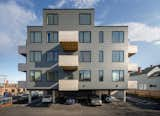
The following is an article from Dwell posted on October 7, 2024, by Sarah Akkoush
Despite its centrally desirable location, the East Bayside neighborhood of Portland, Maine, was historically home to industrial and municipal buildings—warehouses, scrap yards, and low-quality housing dominated the urban landscape for decades. In 2017, however, when Portland’s Public Works Department left the neighborhood, the city looked to sell its surplus land. Answering a competitive RFP, Kaplan Thompson Architects put forth a proposal to build Workforce Housing apartments on a compact, quarter-acre parking lot in Bayside.
Photo by Trent Bell
Kaplan Thompson’s proposal—a residential infill project on the underutilized parcel—aimed to transform “dead” space into a vibrant community, while offering home ownership opportunities to segments of Portland’s population largely overlooked. When its proposal was greenlit by the city, Kaplan Thompson got to work designing a 50-foot residential building on the compact parcel—creating 23 new affordable homes in Bayside’s growing community.
Photo by Trent Bell
In spite of their compact size, the one-bedroom, one-bathroom homes—ranging from 364 to 540 square feet—were designed to be functional and efficient. In organizing the apartments’ interior layout, the Kaplan Thompson team found inspiration in their own backyard. “Portland is an ocean city, so we began by looking carefully at boat design and how a single space could serve multiple purposes,” says architect Adam Wallace. Using these local cues, the design team favored an open floor plan with galley kitchen and movable island—allowing the space to be adaptively reconfigured to fit varying uses. Bedroom and bathroom sizes were strategically minimized in order to prioritize a generous, open-concept living space.
Photo by Trent Bell
Photo by Trent Bell
For the multifamily project, window design was critical to making the compact units feel airy and spacious. “The secret to making small living spaces feel large is high ceilings and windows that are as large as possible,” says Wallace. “We spent a huge amount of time thinking and talking about the windows on this project.” The resultant design saw large windows placed as high to the ceiling as possible—accentuating the verticality of the space, while offering privacy from the street. To provide fresh air, smaller operable windows are positioned next to larger, economical fixed windows in the home’s living room and bedroom—tactfully balancing comfort and cost. Decks off of each unit are a valuable extension of interior space—making the compact homes feel bright and open, and encouraging residents to engage with their neighborhood beyond.
Photo by Trent Bell
Photo by Trent Bell
Photo by Trent Bell
Parris Terraces, says architect Jesse Thompson, helps meet a desperate need for “missing middle” housing—homes that fall in between single-family dwellings and high-density highrises. “By introducing smaller and more affordable units, Parris Terraces welcomes first-time homebuyers into the city and establishes them as permanent residents of a burgeoning neighborhood,” says Thompson. “As a result, an influx of permanent residents lays the foundation for a lasting and growing community.”








